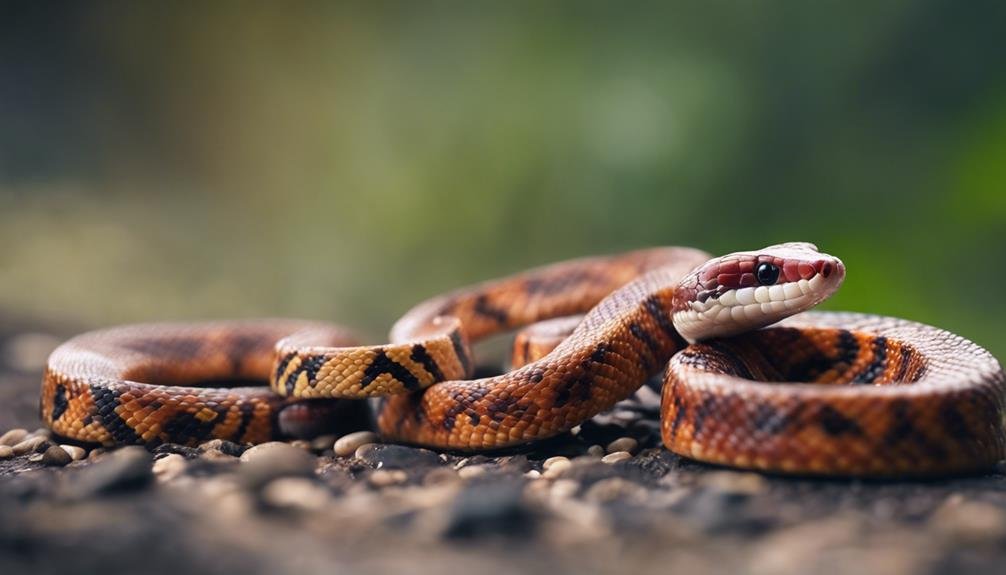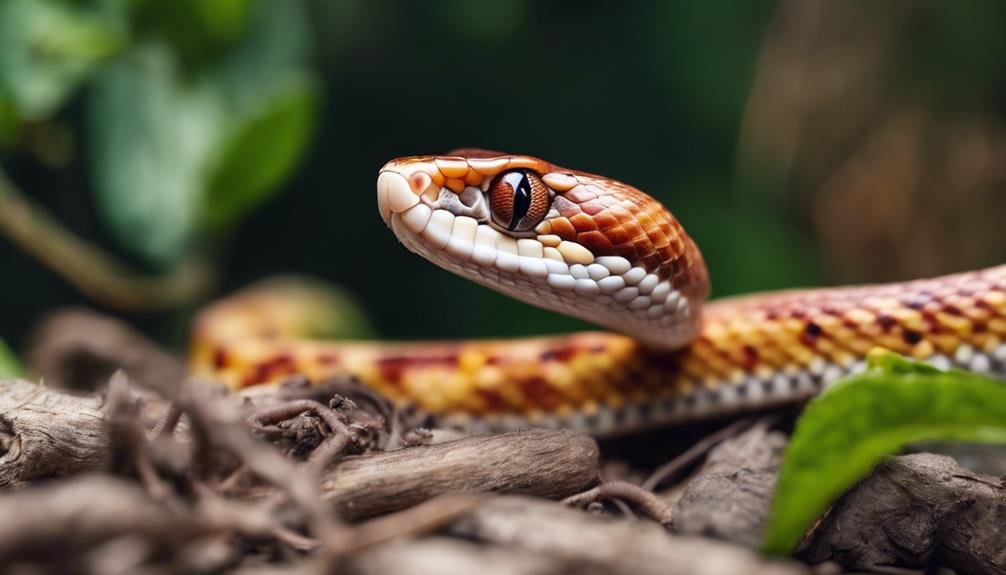As you explore the care of corn snakes, you'll find their digestive cycle intriguing, particularly how often they eliminate waste. Typically, these reptiles will poop every 1-2 weeks, though this frequency hinges on their diet and metabolic rate. If you've noticed your snake exhibiting restlessness or an increased tendency to explore, it might be signaling an impending bowel movement. But, there's more to their excretion habits than meets the eye. Understanding the nuances of their natural cycle can have a big impact on their health and your ability to maintain a clean habitat. Let's explore what influences these cycles and how you can support the digestive well-being of your corn snake.
Key Takeaways
- Corn snakes typically poop once every 1-2 weeks, depending on their diet and metabolism.
- Young or smaller corn snakes may poop more frequently than larger, adult ones.
- A diet higher in nutrition and hydration can lead to more regular bowel movements.
- Environmental factors, like temperature, can influence the frequency of their bowel movements.
- Monitoring poop consistency and frequency helps in assessing the snake's overall health and digestive function.
Understanding Corn Snake Digestion
To keep your corn snake healthy, it's important to grasp how their digestion works. Understanding corn snake digestion is vital for monitoring digestive health and ensuring a clean and healthy enclosure. By keeping an eye on snake poop, you can learn a lot about the well-being of your pet. Normal snake poop after a meal is expected, but you should be alert to changes in poop color or texture, as these can signal digestive health issues.
Maintaining digestive health in corn snakes involves more than just monitoring their waste; it's about understanding their dietary needs and how different foods affect their metabolism. A healthy diet directly influences the frequency and consistency of their poop, making it a key factor in their overall health. Regular checks for any changes in poop color or texture can help you catch potential health issues early, ensuring your corn snake stays healthy and happy.
Frequency of Corn Snake Bowel Movements
Understanding how often your corn snake poops is key to monitoring its health and well-being. The frequency of their bowel movements can vary, often pooping multiple times a week. This variation is largely due to their diet and metabolism. After eating, it's important for corn snakes to show specific behaviors indicating they're about to poop, such as becoming more active or choosing a particular spot in their enclosure.
Monitoring the poop's color and consistency is essential for evaluating your corn snake's health. Typically, their poop is brown and soft. Any changes might indicate health issues. Observing where and how often your corn snake poops can also help you maintain a clean and healthy enclosure by identifying their preferred pooping spots.
| Diet | Metabolism Rate | Poop Frequency |
|---|---|---|
| High | Fast | Several times/week |
| Moderate | Normal | 1-2 times/week |
| Low | Slow | Less frequently |
Understanding these aspects of your corn snake's poop behaviors enhances your ability to provide the best care, ensuring they remain healthy and their habitat stays clean.
Identifying Healthy Corn Snake Poop


You should know that healthy corn snake poop is typically brown and soft. This consistency and color are key indicators of good digestive health in your pet. Regularly checking the poop's appearance can alert you to any potential health issues before they become serious. It's important for the poop to have a strong and unpleasant smell, which shouldn't cause concern.
However, any changes in the color or texture might indicate that something's off. If you notice such changes, it's vital to contemplate what might be causing them. It could be as simple as needing dietary adjustments or, in more severe cases, a sign that veterinary care is needed.
Monitoring the frequency of your corn snake's bowel movements is also essential. An increase or decrease in poop frequency can give you valuable insights into their overall health and whether their diet is suiting their needs. Always remember, a sudden change in poop frequency, color, or texture warrants a closer look. By keeping an eye on these aspects, you're taking proactive steps to make sure your corn snake remains healthy and happy.
Causes of Abnormal Poop Colors
Abnormal poop colors in your corn snake, such as green, yellow, or red, often signal health issues that require immediate veterinary attention. If you're noticing green poop, it might indicate an infection or perhaps a fasting period your snake is going through. Although fasting periods can lead to changes, it's important not to dismiss green poop too quickly, as infections can escalate if not treated.
Yellow feces, on the other hand, could signal something more serious, urging a veterinary visit to address potential health issues. The presence of yellow in your corn snake's poop shouldn't be overlooked, as it might point to underlying concerns that need professional assessment.
Most alarming, however, is red poop, which may indicate the presence of blood. This requires immediate attention from a reptile vet. The presence of blood in your corn snake's poop is a clear sign that something is of great concern, and it's crucial to get it checked out without delay.
Managing and Improving Digestive Health


To guarantee your corn snake's digestive health remains at its best, it's important to monitor their poop for any changes in color or texture. Observing poop frequency, as well as any color and texture changes, can be vital in identifying potential health issues early. Your snake's diet and metabolism play significant roles in their digestive health, influencing how often they poop. A well-balanced diet ensures your corn snake has the nutrients needed for excellent digestion and regular bowel movements.
Monitoring your snake's poop isn't just about keeping an eye out for changes; it's also about maintaining a clean and healthy enclosure. This reduces the risk of health issues related to poor hygiene. Regular veterinary check-ups are essential in managing and improving your corn snake's digestive health. A vet can provide specific advice tailored to your snake's needs, helping to address any concerns related to poop frequency, color, or texture changes.
Is a Corn Snake’s Shedding Cycle Related to its Pooping Frequency?
The shedding cycle of a corn snake is not directly related to its pooping frequency, as these are two distinct processes. The reasons for frequent shedding in corn snakes might be attributed to their growth rate, environmental factors, and overall health. It’s important to monitor both shedding and pooping behaviors for the snake’s well-being.
Conclusion
In summary, you've learned that corn snakes typically poop every 1-2 weeks, depending on their diet and metabolism. By recognizing the signs of their natural cycle and monitoring the color and consistency of their poop, you can guarantee they're digesting properly.
If you spot any abnormal colors, it's important to understand the causes and take steps to improve their digestive health. Keeping a close eye on their bowel movements helps you maintain a clean environment for your slithery friend.


